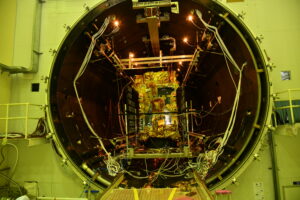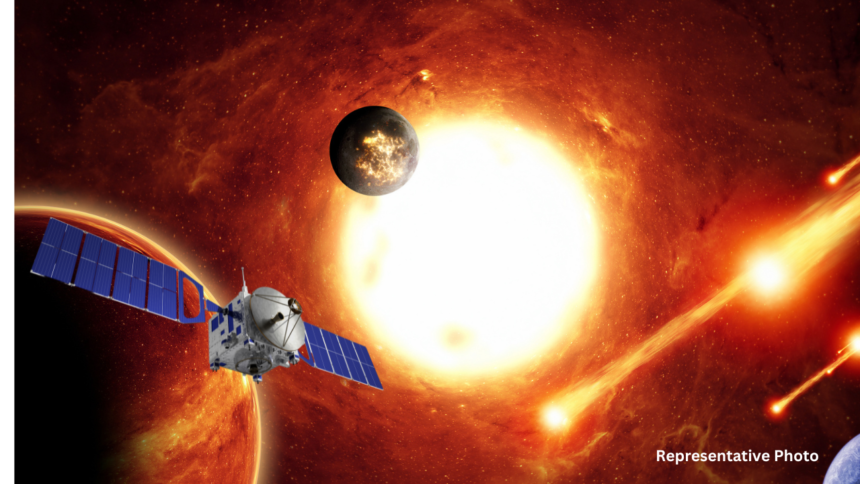New Delhi 11-12-2024
The Aditya-L1 mission of Indian Space Research Organisation (ISRO), have unveiled fascinating details about a solar event that has a profound impact on space weather. Aditya-L1, India’s first space-based solar mission, observed a Coronal Mass Ejection (CME)—a massive burst of solar plasma and magnetic fields ejected from the Sun’s outer atmosphere.
The mission was launched on September 2, 2023, which successfully placed on January 6, 2024 in a halo orbit around the first Sun-Earth Lagrange Point L1, which is about 1.5 million km away from the Earth.

The CME event was observed on July 16, 2024, when a CME, accompanied by a powerful solar flare, erupted from the Sun. Using the Visible Emission Line Coronagraph (VELC), researchers studied the Sun’s corona (its outer atmosphere) in great detail, focusing on light emitted at a specific green wavelength of 5303 Å.
This unique “green light,” caused by iron atoms at incredibly high temperatures in solar corona (over million degrees Celsius), allowed scientists to track the movement of solar material during the CME.
A Coronal Mass Ejection (CME) is a massive release of solar wind and magnetic fields from the Sun’s corona. During a CME, large amounts of charged particles (such as electrons and protons) and plasma are ejected into space at extremely high speeds, often reaching millions of kilometers per hour. When a CME reaches Earth, it can interact with our magnetic field, leading to disturbances that can disrupt satellite communications, GPS systems, and power grids.
CMEs are caused by magnetic activity in the Sun’s corona. The Sun’s magnetic field is highly dynamic, constantly changing and shifting. These changes can cause the magnetic field lines to become twisted and stretched. When these magnetic fields suddenly realign or reconnect, they release a tremendous amount of energy, which pushes solar material outward into space, resulting in a CME.
This explosive release of energy is often associated with solar flares, but CMEs may occur independently of them as well. The accurate connection between CME and solar flares are still a scientific puzzle.
Understanding the causes and behavior of CMEs is crucial for predicting their effects on Earth and protecting our technology from space weather hazards.
The researchers from Indian Institute of Astrophysics reported the following important observations in a paper titled ‘New Results on the Onset of a Coronal Mass Ejection from 5303 Å Emission Line Observations with VELC/ADITYA-L1’ published in peer reviewed International journal ‘The Astrophysical Journal Letter’.
The following key observations about July 16, 2024 CME are reported:
During the Coronal Mass Ejection (CME), the Sun’s outer atmosphere, or corona, became much dimmer in a specific region. The brightness in that area dropped by about 50%, a decrease caused by the ejection of solar material. This reduction in brightness lasted for about 6 hours. This is also known as Coronal dimming.
The temperature around the region of CME is enhanced by about 30% and this region becomes more turbulent during the event. Both these effects are also reflected in the measurement of non-thermal velocity (or chaotic motion) of the plasma which was measured to be around 24.87 km/s. The Sun’s dynamic magnetic field gets more active during such eruptions and is the cause for observed enhanced turbulence.
The Doppler velocity measurements of the ejected plasma during CME is found to be redshifted with a speed of about 10 kilometers per second. It means that plasma is found to be moving away from the observer during the CME event. This also indicates a deflection of CME by the dynamic magnetic field of the Sun. This finding shows that solar magnetic forces can influence the direction of propagation of the ejected plasma as it moves in the inter-planetary space.
The understanding of such deflections of the ejected plasma is important for the prediction of how CME evolves upon leaving the Sun and travelling through the solar system.
The Aditya-L1 mission continues to provide invaluable insights into the Sun’s behavior, laying the groundwork for future research and helping better understand our nearest star.
Aditya-L1 is not just a scientific achievement but also an inspiration for students and young scientists across the country. It shows the power of space research and the potential for India to contribute in solving scientific challenges throughs pace based research.






